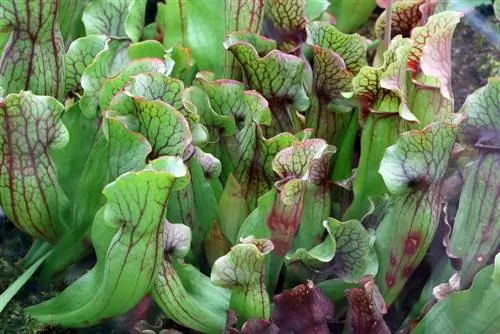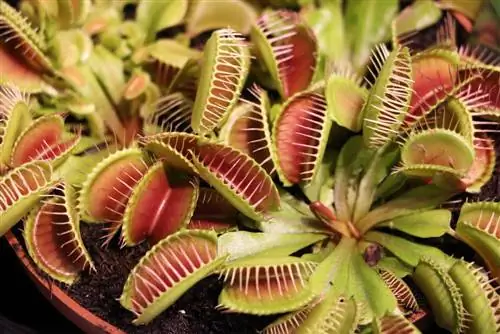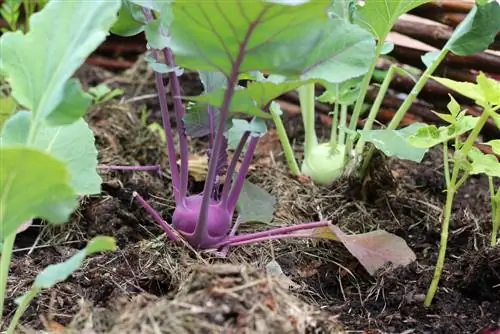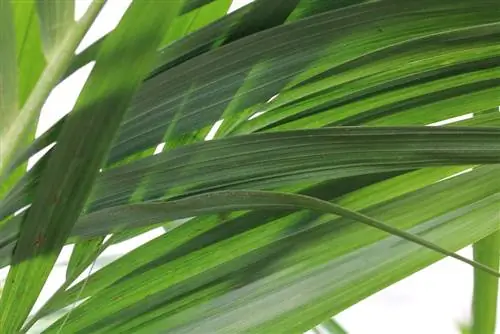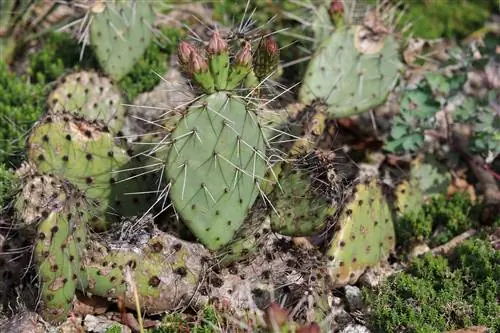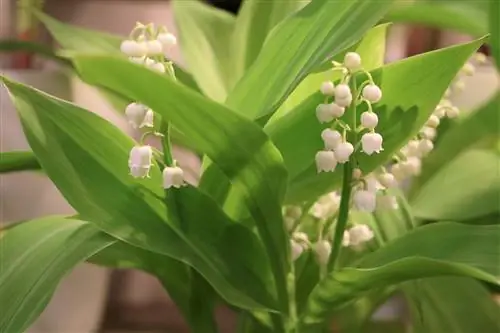- Author admin [email protected].
- Public 2023-12-17 03:39.
- Last modified 2025-01-24 12:45.
Carnivorous plants are a stroke of evolutionary genius for your home windowsill. Carnivores don't just populate tropical regions around the world. From Greenland and New Zealand right up to the highest mountains of Brazil, the fascinating survival artists cavort in places where other plants are at a losing battle. You can even come across sophisticated trappers in European latitudes. This selection introduces you to the most popular species and their ingenious catching mechanisms.
Venus flytrap (Dionaea muscipula)
One of the most popular carnivorous plants for the windowsill comes from the sundew family. Charles Darwin already declared the Venus flytrap to be the most wonderful plant in the world. The carnivore species impresses with its bright red folding traps, which are made up of two leaf halves. There are small bristles along the edges of the leaves that trigger the folding mechanism when prey is within reach. The insides of the red leaves emit an enticing scent of nectar to attract insects and other invertebrates. Within milliseconds the trap closes and the bristles interlock so that there is no escape. A single leaf can perform this capture process up to five times.
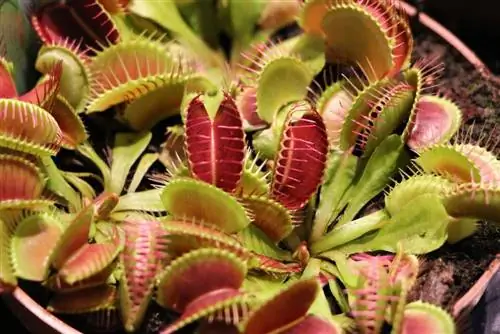
The popularity of Venus flytraps is also based on their magnificent flowers. In early spring, white flowers rise on long stems high above the catch leaves. These are made up of small green sepals and five large petals that do not overlap each other.
- Growth height: 10 cm (up to 50 cm during flowering)
- Flowering period: April to June
Pitcher plant (Nepenthes alata)
Representative of the spectacular genus of pitcher plants, we would like to introduce you to Nepenthes alata 'Ventrata', one of the most popular species and its most beautiful hybrids. The tropical climbing plant forms pitcher-shaped traps up to 50 cm long from some of its leaves and with a fixed lid. It contains an acidic digestive secretion that gives off a sweet smell. The inside walls of a jug are very smooth. If a careless insect lands on the edge of the jug, it will slide inexorably into the liquid and will be used within 2 days.

The euphoria for pitcher plants is primarily based on the aesthetics of their traps. Nevertheless, the carnivores provide floral moments of happiness when they present their decorative flower spikes. During the summer growing season, 15 to 50 cm long stems with reddish inflorescences sprout.
- Growth height: depending on the climbing aid 100 to 250 cm
- Flowering time: during summer
Tip:
Carnivorous plants do not tolerate lime. Therefore, always water your carnivores with collected rainwater, well water or well-stale tap water.
Sundew (Drosera)
The second largest genus of carnivorous plants gives us three hardy carnivores that you can cultivate in your garden. Drosera rotundifolia, Drosera intermedia and Drosera anglica are completely hardy. Although the plants differ in some details, they largely agree on striking characteristics. After a successful catch, their sticky traps move gently back and forth, glittering in the sunlight. The spectacle results from moving tentacles located on the leaves. At their tips, the carnivore secretes a sticky, sugary secretion, which attracts prey to it. The movements gradually strengthen the hold while digestive enzymes slowly break down the victim to extract the nutrients.
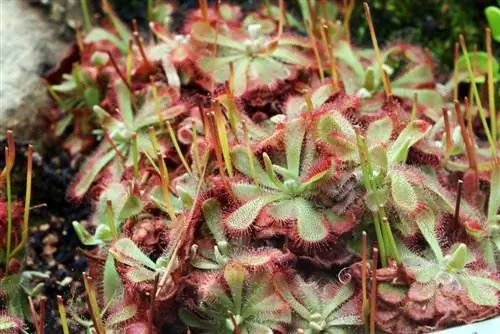
The European, frost-resistant sundew species prefer to thrive in bog beds or along garden ponds. Subtropical and tropical Drosera look great on the windowsill or in terrariums because their minimum temperature is around 20 degrees Celsius. Over the course of the summer they boast five-stellate, white or pink flowers, which unfold at a safe distance from the sticky leaves.
- Growth height: 10 cm (up to 30 cm during flowering)
- Flowering time: between April and August depending on the species and variety
Red pitcher plant, trumpet leaf (Sarracenia purpurea)
The red pitcher plant has emerged as the star of this small genus of carnivores. In contrast to its exotic counterparts, the carnivorous Sarracenia purpurea is reliably winter-hardy, so it thrives equally well indoors and outdoors. The red trumpet leaf shows its most beautiful side in acidic, wet soil. The carnivore species is also useful as a natural and powerful insect trap on the windowsill. Their beauty and effectiveness is based on purple tubes that grow horizontally and are therefore always close to the ground. The upper part of the collection tube is strongly curved and wide open with a collar of nectar. A digestive secretion is added to the collected rainwater in order to quickly decompose attracted prey.
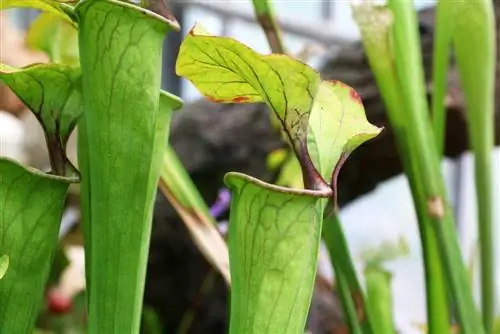
The nodding, reddish to pink flowers are at a sufficient distance from the tube traps so as not to endanger pollinating bees. A single flower stays open for about 14 days. Since new buds continually develop on adult pitcher plants during the summer, the carnivorous species sets decorative accents along swampy pond banks, in bog beds, on the balcony or windowsill over a long period of time.
- Growth height: 10 to 20 cm
- Flowering period: May/June to August/September
Dwarf pitcher (Cephalotus follicularis)
The carnivore species looks very similar to pitcher plants. Of course, there is no botanical relationship. The dwarf mug is very popular among lovers with a penchant for rarities from the kingdom of carnivorous plants. The distribution area of this little beauty, which usually remains at a height of 10 cm, is only found in southwest Australia. In winter, non-carnivorous leaves form seasonally and their task is photosynthesis. From summer to fall, small pitcher traps with lids and conspicuous serrated edges thrive to lure insects to their destruction. The sunnier the location, the more intensely the pitcher-shaped traps turn an intense red to black color.
In contrast to the distinctive pitfall traps, the tiny flowers appear rather inconspicuous. At the beginning of summer in Australia, flower stalks sprout with numerous star-shaped flowers in a panicle arrangement. What is striking is the large safety distance of up to 60 cm that a dwarf pitcher develops between pitcher traps and flowers.
- Growth height: 5 to 10 cm (up to 60 cm during flowering)
- Flowering period: January to February
Tip:
In normal, nutrient-rich potting soil, carnivorous plants have little chance of survival. Special carnivore soil is the best choice as a substrate, as the composition is tailored to the plants' special needs, such as an extra acidic pH value of 3 to 4.
Swamp pitcher (Heliamphora)
Together with the dwarf pitcher, a swamp pitcher forms the dream team among carnivores for the windowsill. In contrast to dwarf jugs, swamp jugs do not have a large lid in order to create a reservoir of rainwater in their collection tube. Trapped insects drown in the liquid before bacteria are released to digest the prey. The funnel-shaped pitfall traps reach typical heights of between 10 and 50 cm, so that a suitable type of swamp jug can be discovered for every design requirement. The greenish and reddish marbled color of the leaves is beautiful to look at. A tip-shaped lid rudiment at the upper end of the trap construction is colored bright red and exudes a special attractant.
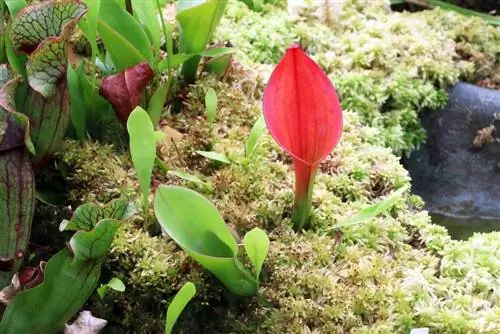
Compared to the extravagant growth habit of their leaf funnels, the flowers on the swamp jug grow inconspicuously. The white to reddish flowers only form when the plant finds a location with 80 to 85 percent humidity and experiences a temperature drop to 8 to 15 degrees Celsius overnight.
- Growth height: depending on the species 10 to 50 cm
- Flowering period: June to September
Watertrap (Aldrovanda vesiculosa)
Are you looking for an aquatic plant that also catches insects? Then the sundew family offers you exactly the right type of carnivore with a water trap. The herbaceous freshwater plant is equipped with mini-format folding traps, as we know them from Venus flytraps. The water trap prefers to use these traps to catch water fleas in order to cover its nutrient needs. Fine hairs and bristles inside and along the edges ensure that prey cannot escape. The 2 to 3 mm small fang leaves are arranged in small whorls along the shoot axes, which are up to 30 cm long. Air-filled cavities provide the necessary buoyancy.
A waterfall only presents its white flowers on short stems for a few hours. As experience shows, this carnivore species can rarely be motivated to bloom outside of its habitat.
- Growth length: 10 to 30 cm
- Flowering time: usually not applicable
Fedwort (Pinguicula)
Among the 85 species within the butterwort genus there are 4 species that you can encounter in the wild in German-speaking countries. The bladderwort plants mostly thrive in the warm regions of Central America, so they are often cultivated as decorative houseplants. Explicitly tropical butterwort species are highly valued because of their beautiful flowers, which tower high above the evergreen, sticky rosettes of leaves. The leaves release the fragrant attractant secretion via glands. The carnivorous plants primarily target mosquitoes, flies and other insects. Once the prey sticks to the blade, there is no longer any chance of escape.
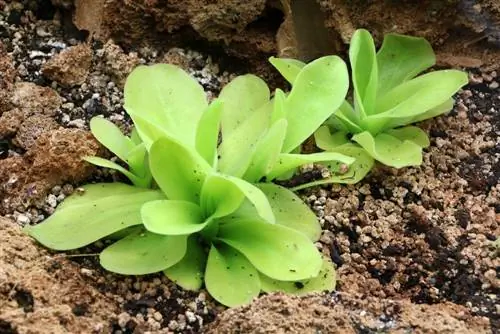
Since all carnivores pay strict attention not to harm their pollinators, the distance between trap leaves and inflorescences is up to 60 cm. The spectrum of decorative flower colors extends from white to soft pink and dark red to violet and yellow.
- Growth height: 15 to 20 cm (significantly higher during the flowering period)
- Flowering period: May to September
Water hose (Utricularia)
Behind her inconspicuous exterior lies a carnivore of superlatives. The more than 200 water bladderwort species are represented around the globe. Utricularia species thrive both floating in water and terrestrially on land. Their trapping bladders are among the most sophisticated traps developed by carnivorous plants. The tiny bubbles are 0.2 to 6 mm in size and are under tension. If potential prey comes into contact with the sensory bristles, it is sucked in within a fraction of a second by creating negative pressure within the bladder. This reflex is considered the fastest movement in the entire plant kingdom. Underwater the process is accompanied by a quiet banging sound.
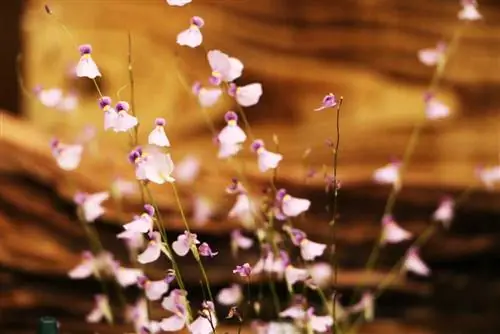
A water hose always blooms above the water or above the substrate. Its spurred flowers form into racemose clusters in a variety of color nuances. Small species produce flowers of a few millimeters, while majestic carnivores produce magnificent flowers up to 7 cm in diameter, reminiscent of orchids.
- Growth height: 30 to 130 cm
- Flowering time: in summer or almost all year round

